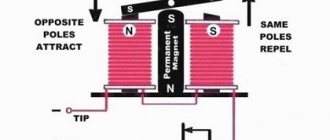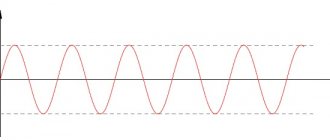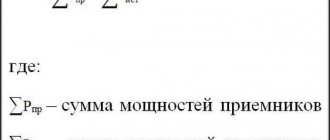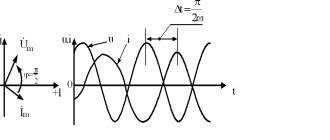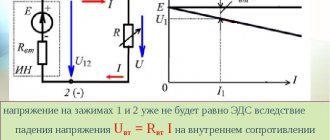What does SOPT consist of?
First, it’s worth saying a little about terminology. This abbreviation can be deciphered as a set of converting, storage and distribution devices of electricity necessary to supply direct operating current to all secondary switching devices connected to it. Power supply is provided:
- In normal mode
- For the required time in the event of voltage failure on the auxiliary buses
Thus, taking into account the request that comes from the operating party, all components included in the COPT may have different designs and parameters. However, in most cases, the DC operating system includes the following elements:
- Rechargeable batteries (AB)
- Charger (charger).
- Operating current control cabinets (SHUOT) or operating current control apparatus (AUOT)
Pros and cons of alternating operating current sources
Typically, such sources on the PS are dependent. Current and voltage transformers are used for this purpose. In this case, energy is used that is supplied to the protected object for transmission to consumers.
The advantages of such power sources include:
- Low cost.
- The connection is made without using an extensive network.
In addition to the advantages, there are also disadvantages:
- Output voltage fluctuations have a significant impact on the operation of microelectronic and analog relays. This increases the risk of failures. If electromechanical relays are used, this influence can be ignored.
- If a breakdown or emergency occurs, the AC sources will not be able to reliably perform their basic functions.
When using alternating current, it is sometimes converted to direct current using rectifiers. The quality of the source in this case is largely determined by the choice of connection diagram.
Capacitor units can be used as an alternative source of alternating operating current. Under normal power supply conditions, the capacitor is charged from the connected charger. When the primary voltage disappears, the capacitor begins to discharge, while providing power to the devices connected to it. The disadvantage of this scheme is the rapid discharge of the capacitor.
Principle of operation
Charger – generates rectifying voltage, charges batteries and powers consumers, coping with the following types of loads:
- Constant – equipment power supply
- Temporary – in emergency situations
- Short-term – when starting electrical appliances
Batteries - from them current flows to the substation in cases where for one reason or another (primarily due to an accident) there is no current there. The battery operating time of devices depends on the number and capacity of the connected batteries.
SHUOT and AUOT - operational current distribution cabinets identify damaged elements and turn them off using selective circuit breakers. It is important to use switches from only one manufacturer.
Types of SOPT by structure
The system can have 2 types of structures:
- Centralized – 1 set of DC sources to power a separate consumer group
- Decentralized – 2 or more sets
One of the most popular SOPT configurations today is the operating current control device. It includes 3 cabinets:
- operational current and control
- rechargeable batteries (SHAB)
- distribution of direct operating current (ShR or ShVR)
From a design point of view, SHUOT and AUOT are complete low-voltage cabinet-type devices. Cabinets can have a high degree of protection (to ensure the safety of the equipment installed inside). Measuring instruments and lighting fixtures are installed on the façade to monitor the condition of switching devices and alarm signals. Inside the cabinets are divided into compartments:
- Busbar and distribution bus
- Functional equipment
- Cable connections
Protection against short circuits and overloads in switchboards is provided by switching devices. They create a 3-level protective system:
- Protection of power input circuits
- Protection of power distribution circuits by groups of electrical receivers
- Protection of power supply circuits of direct consumers
Why is an operational DC system required?
Consumers who need SOPT - operational circuits of protection, control, automation and telemechanics, alarm (emergency, warning). These are circuits of electromagnets for switching off and on switching devices, control devices, automation, alarms, protection and measurement, telemechanics and other things.
All of these are secondary circuits of power plants and substations, or, as they are called, auxiliary circuits. A typical example of the use of COPT is power supply to equipment due to a substation failure, emergency lighting.
Accordingly, the system is used in these circuits for the following purposes:
- Reception and conversion of alternating current to direct current
- Storage of DC electricity in batteries
- 110 and 220 V DC distribution
- Power supply of the emergency lighting line from the DC mains in case of loss of supply voltage in the AC mains
- Measurement and control of parameters of auxiliary circuits
What is operative current
The main purpose of a power plant is to supply energy to consumers. The effectiveness of its operation largely depends on the functioning of systems that ensure:
- Operating mode management.
- Adjustment of processes designed to perform certain actions.
- Alarm activation.
- Relay protection.
- Automation operation.
Such systems need to be provided with uninterrupted power supply. It must be taken into account that the slightest failure can cause an accident. It is important that the power sources used fully ensure the operation of the relevant devices.
In a broader sense, operating current can be considered as that which is used to operate various devices that provide regulation and control functions for the corresponding system.
Types of current and systems (devices)
Operating current varies. Accordingly, the systems for delivering it to devices are also different.
- Constant OT (operational current) - a rechargeable battery and chargers are used as IP
- Alternating OT - measuring current transformers, voltage transformers, auxiliary transformers, pre-charged capacitors are used as IP
- Rectified OT - here the role of IP is played by power supplies and rectifying power devices, as well as pre-charged capacitors.
- Mixed - a combination of the above systems is used.
Purpose of the operational current system at electrical substations
The combination of power supplies, cable lines, power buses of switching devices and other elements of operational circuits constitutes the operational current system of a given electrical installation. Operating current at substations serves to power secondary devices, which include operational protection circuits, automation and telemechanics, remote control equipment, emergency and warning alarms. In case of disturbances in the normal operation of the substation, the operational current is also used for emergency lighting and power supply to electric motors (especially critical mechanisms).
Requirements for operational current systems
Operational current systems are subject to high reliability requirements in the event of short circuits and other abnormal conditions in the main current circuits.
Classification of operational current systems at electrical substations
The following operational current systems are used at substations:
1) direct operating current - an operating circuit power supply system in which a rechargeable battery is used as a power source; ;
2) alternating operational current - a power supply system for operational circuits, in which measuring current transformers of protected connections, measuring voltage transformers, and auxiliary transformers are used as the main power sources. Pre-charged capacitors are used as additional pulsed power sources;
3) rectified operating current - a system for powering operating circuits with alternating current, in which alternating current is converted into direct (rectified) using power supplies and rectifying power devices. Pre-charged capacitors can be used as additional pulsed power sources;
4) mixed operating current system - an operating circuit power supply system in which different operating current systems are used (direct and rectified, alternating and rectified).
In operational current systems there are:
— dependent power supply, when the operation of the operational circuits power supply system depends on the operating mode of a given electrical installation (substation);
— independent power supply, when the operation of the operational circuits power supply system does not depend on the operating mode of the electrical installation.
Application areas of various auxiliary current systems
Direct operating current is used at 110-220 kV substations with busbars of these voltages, at 35-220 kV substations without busbars at these voltages with oil switches with an electromagnetic drive, for which the possibility of switching on from rectifier devices has not been confirmed by the manufacturer.
Alternating operating current is used at 35/6(10) kV substations with 35 kV oil circuit breakers, at 35-220/6(10) and 110-220/35/6(10) kV substations without circuit breakers on the high voltage side, when the circuit breakers 6(10)-35 kV are equipped with spring drives.
Rectified operational current should be used: at 35/6(10) kV substations with 35 kV oil circuit breakers, at 35-220/6(10) kV and 110-220/35/6(10) kV substations without circuit breakers on the high voltage side when the switches are equipped with electromagnetic drives; at 110 kV substations with a small number of oil circuit breakers on the 110 kV side.
22 Neutral operating modes
Neutrals of electrical installations are the common points of three-phase windings of generators or transformers connected in a star .
Solidly grounded neutral - the neutral of a transformer or generator connected directly to the grounding device. The output of a single-phase alternating current source or the pole of a direct current source in two-wire networks, as well as the midpoint in three-wire DC networks, can also be solidly grounded.
An electrical network with an effectively grounded neutral is a three-phase electrical network with a voltage above 1 kV, in which the ground fault coefficient does not exceed 1.4.
The earth fault coefficient in a three-phase electrical network is the ratio of the potential difference between the undamaged phase and the earth at the point of earth fault of the other or two other phases to the potential difference between the phase and the earth at this point before the fault.
In systems with an effectively grounded neutral, the neutrals of transformers and autotransformers are tightly grounded or through reactors with low inductive reactance in such a way that when shorted, the voltage of the undamaged phases relative to the ground does not exceed 1.4 UF, and the single-phase short-circuit current at any point in the system is at least 60% three-phase short circuit current at the same point.
Systems with an effectively or solidly grounded neutral are classified as systems with high ground fault currents (IЗ > 500 A).
To limit ground fault currents, the zero-sequence resistance is artificially increased by grounding only part of the transformer neutrals (one or two) at each substation or by grounding the neutrals through active or reactive resistances. However, an increase in the zero-sequence resistance leads to an additional increase in voltage in healthy phases during asymmetrical short circuits [2], [3].
Isolated neutral - the neutral of a transformer or generator, not connected to a grounding device or connected to it through a high resistance of signaling, measuring, protection and other similar devices.
Networks with a rated voltage of up to 1 kV , powered by step-down transformers connected to networks with UHOM > 1 kV, are carried out with solid neutral grounding .
Networks with UHOM up to 1 kV , powered from an autonomous source or an isolation transformer (according to the condition of ensuring maximum electrical safety in case of ground faults), are carried out with an insulated neutral .
The operation of electrical networks with a voltage of 2-35 kV can be provided either with an isolated neutral or with a neutral grounded through an arc suppression reactor or resistor .
Compensation for capacitive ground fault current should be applied for the values of this current in normal modes:
a) in networks with a voltage of 3-20 kV, having reinforced concrete and metal supports on overhead power lines, and in all networks with a voltage of 35 kV - more than 10 A;
b) in networks that do not have reinforced concrete and metal supports on overhead power lines:
- more than 30 A at a voltage of 3-6 kV;
— more than 20 A at a voltage of 10 kV;
- more than 15 A at a voltage of 15-20 kV;
c) in generator voltage circuits of 6-20 kV generator-transformer blocks - more than 5 A.
Systems with an isolated neutral or a neutral grounded through a reactor are classified as systems with low ground fault currents (IЗ ≤ 500 A).
The operation of electrical networks with a voltage of 110 kV can be provided with both a solidly grounded and an effectively grounded neutral .
Electrical networks with voltages of 220 kV and higher must operate only with a solidly grounded neutral .
For ground fault currents of more than 50 A, it is recommended to use at least two grounding reactors.
23 Scope of application of autotransformers
Autotransformers are used to both step down and step up voltage. Three-phase autotransformers are also widely used. Autotransformers with a power of up to 1 kVA are widely used in automation and household appliances. More powerful autotransformers are used to reduce the voltage when starting powerful AC motors. High-power power autotransformers are used to interconnect high-voltage electrical networks with similar levels of these voltages. The power of such autotransformers reaches several hundred megavolt-amperes.
Power autotransformers, as a rule, have an additional LV winding (6-35 kV), connected in a triangle. This winding has no electrical connection with the main windings of the autotransformer and serves to compensate for the third harmonic components of the flows or zero-sequence flows. Sometimes it is used to supply electricity to local consumers.
All windings of each phase of the autotransformer (including the additional winding) are located on one rod in the form of concentric coils of the same height, which helps reduce their inductive leakage resistance. The LV winding is located closer to the rod.
These autotransformers are designed to operate in a three-phase group.
24 Methods for limiting short circuit current
Protection methods
To protect against short circuits, special measures are taken:
Short circuit current limiting:
install current-limiting electrical reactors
They use parallelization of electrical circuits, i.e. disconnecting sectional and busbar switches
use step-down transformers with split low voltage windings
they use disconnecting equipment - high-speed switching devices with a short-circuit current limiting function, i.e. fuses, circuit breakers
Relay protection devices are used to disconnect damaged sections of the circuit
25 Current-limiting reactors
Reactors serve to artificially increase the resistance of a short-circuited circuit, and, consequently, to limit short-circuit currents and maintain the required voltage level in case of damage behind the reactors.
The reactor is an inductive coil without a core, so its resistance does not depend on the current flowing.
Current-limiting reactors are used at stations such as thermal power plants:
a) between sections of the GRU ( sectional reactors) - LRK reactor in Figure 7.35, a;
b) to power local consumers from GRU busbars ( linear LR1 or group LR2 reactors) - Figure 7.35,a;
c) to supply local consumers from block heat and power plants through reacted taps - Figure 7.35, b.
Current-limiting reactors can be installed in the low-voltage input circuits of step-down transformers at substations.
a - at thermal power plants with a main distribution unit; b - at block-type thermal power plants
Figure 7.35 — Connection diagrams for current-limiting reactors
The turns of the winding are insulated from each other, wound on a special frame and reinforced in concrete columns, which prevent their displacement under the influence of their own mass and electrodynamic forces during the flow of short-circuit currents. The reactors are isolated from grounded structures, and when installed vertically, from adjacent phases using support insulators. Concrete reactors are available with rated currents up to 4000 A and are manufactured for vertical, horizontal and stepped installation. At high rated currents, in order to reduce active power losses in the reactors themselves, they are performed with artificial cooling (chamber ventilation).
Twin reactors of the RBS series have an additional outlet from the midpoint of the winding. The middle terminal divides the reactor winding into two branches, wound accordingly. Both branches are designed for the same rated current, the value of which is specified in the catalog. The middle terminal is usually connected to a power source and is designed for double the rated current (Figure 7.37a).
The inductances of the L branches are the same, therefore the inductive reactance of each branch of the reactor in the absence of current in the other is xv = coL and is called the nominal resistance of the branch xNOM, V (specified in the catalogue). The features of a dual reactor are determined by the presence of a magnetic coupling between the branches (mutual inductance M).
a - connection diagram; b - load mode; c - short circuit mode
Figure 7.37 - Twin reactor
Let's consider the operation of a dual reactor in load mode (Figure 7.37b). During operation, they try to load both branches of the reactor evenly, then Ix = h-1, and the resistance of each branch will be
(7.2)
where kSV = M/L is the coupling coefficient of the reactor windings (usually dual reactors are made with kSV = 0.4... 0.6).
If we take kSV = 0.5, then in load mode the resistance of each branch of the reactor will decrease compared to a similar single reactor and will be
(7.3)
A dual reactor allows you to reduce the voltage drop (reduce power losses) in each branch of the reactor in load mode and reduce the overall dimensions of the switchgear.
Let's consider the short circuit mode behind one of the reactor branches (Figure 7.37c).
The magnitude of the short-circuit current in this mode will be determined by the inductive reactance of the branch of the reactor through which it flows, i.e.
(7.4)
In short-circuit mode, a dual reactor limits the short-circuit current in the same way as a single reactor with the same nominal parameters.
Currently, they produce dry single current-limiting reactors of internal installation of the RTOS type, designed for UNOM = 10 kV, INOM = 1600, 2500, 4000 A.
The main advantages of using SOPT at facilities
- Ease of operation, inspection and maintenance of secondary switching circuits (they are placed in a separate compartment) and primary circuit devices
- Ease of adaptation to the specific needs of a particular customer
- Possibility of using circuits with stationary and withdrawable circuit breakers of selective and non-selective types, as well as using protection, alarm and control equipment based on modern relay equipment and microprocessor devices
- Easy installation - minimum installation work, since COPT can already be supplied in the form of separate cabinets or fully assembled
You can verify these and other advantages of COPT for yourself by purchasing operational direct current systems produced by RUSELT. We offer you a variety of design solutions and guarantee reliability and high functionality of the equipment.
| Operating direct current systems - SOPT |
Purpose
Direct operating current is used at distribution points (DP) 6(10) kV, as well as at all substations 35 kV and above at newly installed facilities [1].
Alternating operating current is used at distribution points (DP) 6(10) kV, at existing substations 35/6(10) kV, and substation 35-220 kV without circuit breakers on the high voltage side.
Rectified operational current is used at existing 35/6(10) kV substations, and 35-220 kV substation without circuit breakers on the high voltage side.
Thus, the most promising at the moment is the operational direct current system, despite the fact that its use requires the installation of rechargeable batteries (AB), which increases the cost of the structure and necessitates the organization of a direct current network.

